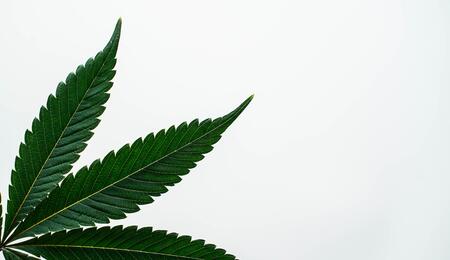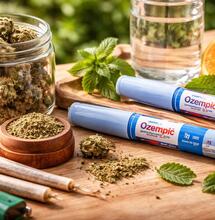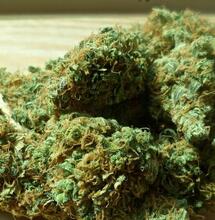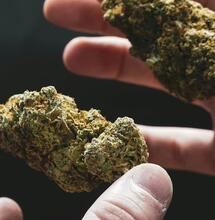Synthetic Pot

We've all seen the endless pages of questionable, lurid ads filling various weed magazines and websites, screaming for you to buy their mysterious bud-like objects in inch-high Word Art - but is there any truth to the claims these ads make? What's in the stuff, and what does it do? There is no simple answer. There are hundreds, if not thousands of different products, and while some are simple blends of (hopefully) harmless herbs, an increasing percentage is made up of far more worrying synthetic chemicals derived from THC - but whose effects may be very different from the Δ⁹-THC we all know and love.
As many will no doubt be aware, in March 2011 the DEA made the previously legal product SpiceTM a Schedule I substance, simultaneously specifying five synthetic cannabinoids to be outlawed. In this article I'll take a look at them - but I'll also be looking at some of the true medicinal plants themselves, and their uses, both medical and recreational. The US is not alone in outlawing these laboratory-made chemicals, which are often many times stronger than THC itself and may have serious side-effects.
The UK, Germany, Finland, New Zealand and many more have made rapid legislative moves to ban numerous synthetic cannabinoids, mostly in response to marked increases in emergency calls and hospitalizations as a result of their consumption. The five cannabinoids outlawed by the DEA are cannabicyclohexanol, JWH-018, JWH-073, JWH-200, and CP-47497, all considered to be highly hazardous to health. HU-210 is another well-known ingredient in many synthetic Cannabis blends, and is a THC analog that may be several hundred times more potent than its natural counterpart.
Many of these synthetic cannabinoids were first isolated by respected organizations: the Hebrew University synthesized HU-210 in 1988, and Pfizer developed cannabicyclohexanol in 1979. They have established medical uses - they are all analgesics, and HU-210 can also reduce inflammation, particularly in the case of Alzheimer's disease; JWH-200 has less sedative effect than THC. Despite their known uses, they are not fully understood; when used recreationally, they have been implicated in a number of adverse reactions.
JWH-018 has addictive properties, causing withdrawal and toxicity if consumed long-term. It has been blamed for at least one death, apparently causing organ failure in a South Carolina college basketball player in October 2011. It is also thought to cause dissociative- or psychotic episodes in otherwise healthy individuals. All five synthetic cannabinoids are thought to intensify or cause symptoms of psychosis - as has THC, but Cannabis itself usually contains CBD, which mitigates the psychotic effect. It has been suggested that synthetic Cannabis blends may cause greater incidents of psychosis and mental illness due to the lack of CBD to mitigate the effect. Although these substances can be useful in the right hands, it is irresponsible to sell potentially inferior, cheaply-manufactured versions of them to consumers who are wholly ignorant of the risk.
However, to knowingly deceive the consumer as to the contents of the blend is beyond irresponsible - it is reprehensible. Some of the more dubious synthetic THC products initially marketed themselves as being simple herbal blends, before being tested and found to be factory-made chemicals sprayed on otherwise completely inactive plant matter. This scam has, understandably, shaken the confidence of many consumers as they are entirely unsure which products to trust - let alone affected the cause for cannabinoid research in a negative way! Right now purveyors of natural, herbal Cannabis alternatives have been finding it difficult to distinguish themselves from the now illegal and largely discredited synthetic THC derivatives. Even when buying true herbal blends, uncontaminated by synthetic THC, consumers run the risk of receiving bags of low-quality, unidentifiable shreds of vegetation, which may not have been grown to particularly exacting standards. There are some websites available that claim to sell organic, hand-selected premium products, which are often sold as individual plants rather than pre-blended mixes. Here a careful consumer may stand a better chance of receiving products that are what they say they are, and do what they say they'll do.
These herbs are mainly sold for their psychoactive effect, which - when smoked, vaporized, infused or extracted, alone or in various blends - can mimic the effect of Cannabis to varying degrees. They are understandably more popular in areas where access to Cannabis is restricted, as consumers seek to achieve the effect of their drug of choice without necessitating recourse to illegal activity. However, medical users of Cannabis are strongly advised to research the potential side-effects of any herb or herbal blend with which they wish to experiment, as the medicinal effects of Cannabis are not necessarily mimicked in the same way as the recreational ones. That said, some of these plants do possess medicinal qualities in their own right - some of which can be powerful indeed. St. John's Wort, or Hypericum perforatum, is a small yellow-flowered perennial (originally native to Europe but brought to North America by early settlers) considered an invasive weed by many countries. An effective anti-depressant that can strongly interfere with other medications, St. John's Wort has been used in folk remedies for centuries, and in modern times is widely prescribed in capsule or pill form to those suffering from mild depression. In clinical trials, it has also been found to be more effective than placebos at alleviating the symptoms of major depressive disorder.
It is useful in treating infected and inflamed wounds and skin conditions. However, although side-effects are widely held to be far less extreme than with many anti-depressants, St. John's Wort may aggravate symptoms of psychosis in schizophrenics, might lead to drowsiness and digestive issues, or potentially reduce the effectiveness of other medications. There is a further, grave risk of serotonin toxicity - which can be fatal - occurring in those who combine St. John's Wort with certain anti-depressants, opioids and central nervous system (CNS) stimulants (including cocaine and amphetamines), as with LSD, MDMA and psilocybin. Damiana, whose Latin name is Turnera diffusa, is another small, yellow-flowered shrub, native to South-, Central-, and (southern) North America, as well as some parts of the Caribbean. It has an aroma similar to chamomile, and is a member of the Passifloraceae or Passion Flower family - which is apt, due to its strong aphrodisiac effect. It has been used by indigenous Mexican tribes for centuries for this purpose, and has been shown in laboratory tests on rats to be highly stimulating even to 'sexually exhausted' and impotent males.
It is thought that damiana may be an aromatase inhibitor - this class of drug restricts production of estrogen, which may account for damiana's aphrodisiac nature, and also may be useful in treating breast cancer in post-menopausal women. It is also held to be anti-depressant, energy- and mood-boosting, hormone-balancing and an appetite stimulant. It is worth noting that research into the medicinal uses of this plant has been mostly inconclusive; also that since the 2005 passing of the Louisiana State Act 159, it has been prohibited - save for strictly decorative purposes - in that state. Elsewhere in the USA, and indeed throughout the world, it is legal. Blue Egyptian lotus (Nymphaea caerulea) is a beautiful waterlily native to the Nile Delta, and also common in India and other parts of Asia and Africa. It has been used for sacramental and ritual purposes for thousands of years, and may well have been the lotus consumed by the Lotophagi, or lotus-eaters, mentioned in Homer's Odyssey. The petals are steeped in alcohol for several weeks to make a tincture; they can also be lightly boiled for twenty minutes for a tea, and the dried leaves can be smoked.
The effect is sedative and mildly psychoactive, and is said to bring a sense of tranquility and mental well-being. However, an alkaloid found in blue lotus, nuciferine, can cause catalepsy (rigidity of the muscles similar to that caused by Parkinson's disease or epilepsy) so it is important to research this plant before use. The blue lotus, although not a true lotus, is from a related genus. The tubers and rhizomes of all waterlilies and lotuses are edible, and the leaves and flowers of many varieties may also be eaten. Interestingly, the true lotus (Nelumbo nucifera) also contains nuciferine, but is far more important to humans as a food source than an entheogen. Leonotis leonuris, commonly known as lion's tail or wild dagga, is an evergreen plant with bright orange flowers, abundant in southern Africa. Wild dagga is widely known in local communities to provide a similar, but less powerful, effect to marijuana when smoked: calming, sedative, and euphoric - but possibly also causing nausea, lightheadedness, dizziness and sweating. It is thought to have a hypoglycemic effect (i.e. it lowers blood sugar), and may be anti-inflammatory when applied topically, as well as reducing nervous pain.
It has traditionally been used to treat a plethora of complaints including intestinal parasites, arthritis, menstrual problems, and eczema - all problems that have been at one time or another treated by various parts of the Cannabis plant. Wild dagga leaves are reported to be harsh and irritating when smoked, although the flowering tops may be more pleasant in taste. It is often more palatable in tea form. There is also a related species, Leonotis sibiricus or honeyweed, which contains several of the same alkaloids as wild dagga, most notably leonurine, which has been shown to be effective in treating infections such as streptococcus. Other lesser-known herbs that may be worth investigating include Lactuca virosa, colloquially known as wild lettuce or opium lettuce. This is another yellow-flowered shrub - a biennial originally from the south and south-east of England. Its effects are sedative, analgesic and somewhat hypnotic, and it was widely used as a substitute for opium by doctors of the 19th century. Bay bean (Canavalia rosea), is a salt-resistant vine that is widespread throughout the dunes and cliffs of the coastal tropics.
This plant was important to indigenous Mexicans, and was used not only as a Cannabis substitute but also to treat skin complaints, arthritis, and fibromyalgia. The seeds and leaves may be smoked, and apparently have a very fragrant aroma. Zornia latifolia is yet another yellow-blossomed herb, native to South America, and is very popular as an ingredient in Cannabis substitutes. The seeds are the only part of the plant commonly smoked. Finally, the Indian warrior (Pedicularis densiflora) is a perennial with distinctive reddish-purple, many-petaled flowers, and is native to California and Oregon. These striking blooms are made into tea or tincture, and are also popular in smoking blends due to their agreeable appearance and flavor. It is thought to provide a relaxing, calming effect. All of these herbs - as well as many more that could not be included in this article - are legal to cultivate, possess and utilize throughout the United States (although residents of Louisiana are advised to check the details of State Act 159).
However, the research is far from exhaustive on some of these species, and side-effects and toxicity levels not always firmly established. That said, with a little investigation and experimentation it should be possible for most people to find an herb or blend that suits their specific needs, be it recreational or medicinal. Anyone seeking to use these herbs to treat serious medical issues should consult their physician prior to commencing treatment. It is strongly recommended that consumers look for reputable sources for these herbs - they are legal, and as such it shouldn't be too hard to find reasonable-quality products, either locally or online. If the sole option is an online outlet, buy small samples at first to be sure that the quality is up to par. If local outlets are available, look before you buy! Don't be afraid to ask questions about how old the product is, how it was grown and where it was sourced - and if there is any hint of synthetic THC, leave the store without buying anything.



